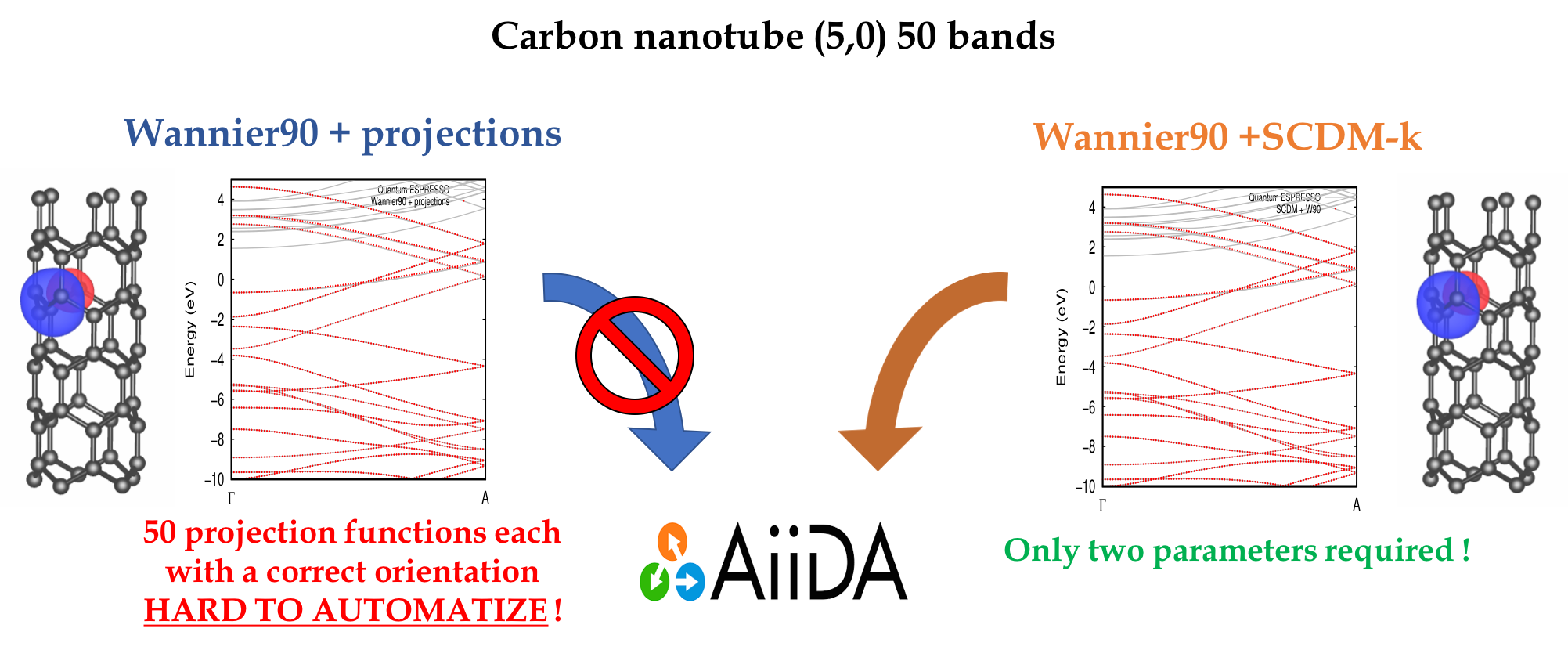Wannier90 is a post-processing tool for the computation of the Maximally Localised Wannier Functions (MLWFs) , which have been increasingly adopted by the electronic structure community for different purposes. The reasons are manifold: MLWFs provide an insightful chemical analysis of the nature of bonding,
and its evolution during, say, a chemical reaction. They play for solids a role similar to localized orbitals in molecular systems. In the condensed matter community, they are used in the construction of model Hamiltonians for, e.g., correlated-electron and magnetic systems.
Also, they are pivotal in first-principles tight-binding Hamiltonians, where chemically-accurate Hamiltonians are constructed directly on the Wannier basis, rather than fitted or inferred from macroscopic considerations, and many other applications, e.g. dielectric response and polarization in materials, ballistic transport, analysis of phonons, photonic crystals, cold atom lattices, and the local dielectric responses of insulators, for reference see .
This module is a first step towards automation of MLWFs. In the original Wannier90 framework, automation of MLWFs is hindered by the difficult step of choosing a set of initial localized functions with the correct symmetries and centers to use as initial guess for the optimization. As a result, high throughput calculations (HTC) and big data analysis with MLWFs have proved to be problematic to implement.
The SCDM-k method removes the need for an initial guess altogether by using information contained in the single-particle density matrix. In fact, the columns of the density matrix are localised in real space,
![\rho(\mathbf{r},\mathbf{r'}) \propto \exp\left[-\gamma|\mathbf{r} - \mathbf{r'}|\right]](../../../_images/math/e0aabbf8a33b114c5f7d3467d96e64df52c1efc3.png) and can be used as a vocabulary to build the localised Wannier Functions. The SCDM-k method can be used in isolation to generate well localised WFs. More interestingly, is the possibility of coupling the SCDM-k method to Wannier90. The core idea is to use WFs generated by the SCDM-k method as initial guess in the optimisation procedure within Wannier90.
This module is a big step towards automation of Wannier Functions and simplification of the use of the Wannier90 program. The module is therefore intendedfor all the scientists that benefit from the use of Wannier Functions in their research. Furthermore, by making the code more accessible and easier to use, this module will certainly increase the popularity of the Wannier90 code.
and can be used as a vocabulary to build the localised Wannier Functions. The SCDM-k method can be used in isolation to generate well localised WFs. More interestingly, is the possibility of coupling the SCDM-k method to Wannier90. The core idea is to use WFs generated by the SCDM-k method as initial guess in the optimisation procedure within Wannier90.
This module is a big step towards automation of Wannier Functions and simplification of the use of the Wannier90 program. The module is therefore intendedfor all the scientists that benefit from the use of Wannier Functions in their research. Furthermore, by making the code more accessible and easier to use, this module will certainly increase the popularity of the Wannier90 code.
The module is part of the pw2wannier interface between the popular quantum ESPRESSO code link and Wannier90. It will be part of the next version of quantum ESPRESSO v.6.3 and Wannier90. Moreover, it has been successfully added in a developer branch of the AiiDA workflow to perform HTC on large material datasets.
For building the module one “simply” has to compile the quantum ESPRESSO program (v.6.2 and later), since the actual routine is inside the pw2wannier90.f90 interface. This will produce the executable pw2wannier90.x. Instructions on how to achieve this are given in the quantum ESPRESSO web documentation.
For testing the module one also needs the wannier.x executable.

![\rho(\mathbf{r},\mathbf{r'}) \propto \exp\left[-\gamma|\mathbf{r} - \mathbf{r'}|\right]](../../../_images/math/e0aabbf8a33b114c5f7d3467d96e64df52c1efc3.png) and can be used as a vocabulary to build the localised Wannier Functions. The SCDM-k method can be used in isolation to generate well localised WFs. More interestingly, is the possibility of coupling the SCDM-k method to Wannier90. The core idea is to use WFs generated by the SCDM-k method as initial guess in the optimisation procedure within Wannier90.
This module is a big step towards automation of Wannier Functions and simplification of the use of the Wannier90 program. The module is therefore intendedfor all the scientists that benefit from the use of Wannier Functions in their research. Furthermore, by making the code more accessible and easier to use, this module will certainly increase the popularity of the Wannier90 code.
and can be used as a vocabulary to build the localised Wannier Functions. The SCDM-k method can be used in isolation to generate well localised WFs. More interestingly, is the possibility of coupling the SCDM-k method to Wannier90. The core idea is to use WFs generated by the SCDM-k method as initial guess in the optimisation procedure within Wannier90.
This module is a big step towards automation of Wannier Functions and simplification of the use of the Wannier90 program. The module is therefore intendedfor all the scientists that benefit from the use of Wannier Functions in their research. Furthermore, by making the code more accessible and easier to use, this module will certainly increase the popularity of the Wannier90 code.